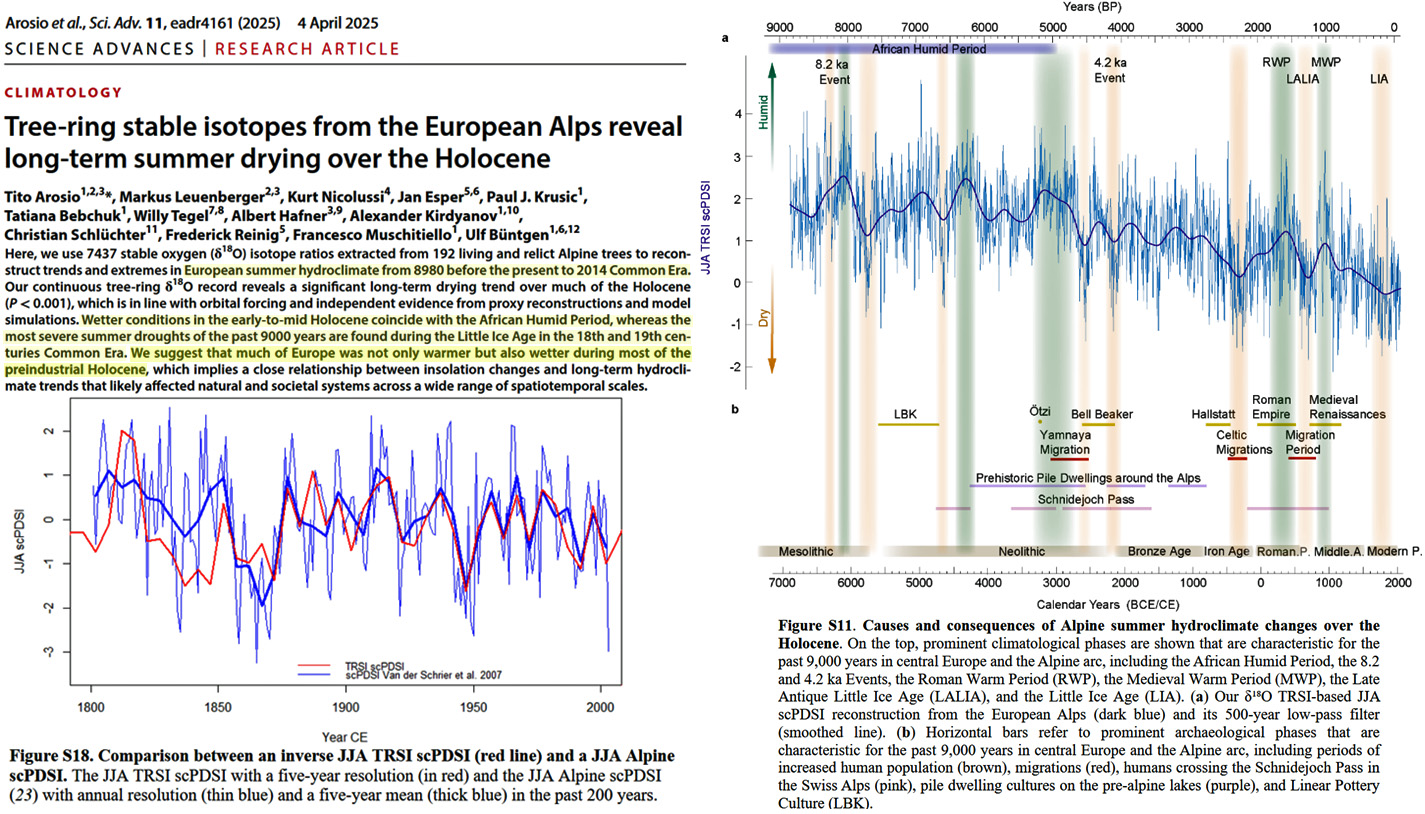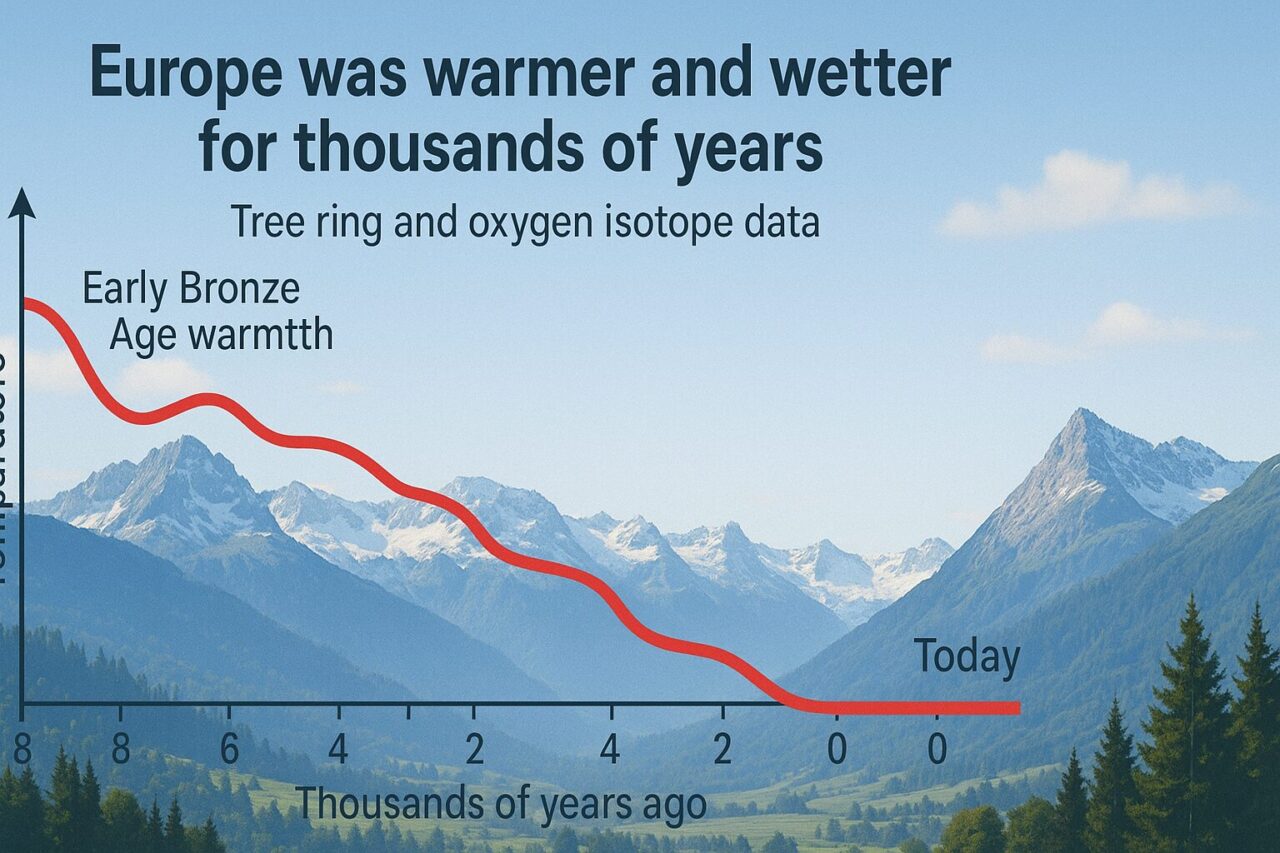Europe’s current climate is colder and drier than the climate in our latitudes a few thousand years ago. According to analyses of tree clusters found in the Alps, it was the optimal climate for life to flourish and human cultures to thrive.
While our climate apocalyptics predict our doom every day, the Alps stand as silent witnesses to a very different truth. In their heights, centuries-old trees grow, preserving the true history of our climate in their rings. What they reveal will turn the climate madness of our time completely upside down, writes Heinz Steiner.
A glimpse into the past through the lustre of wood
Far from the hubbub of climate hysteria, a team of scientists led by Tito Aroso has been doing real scientific research. Their study of 192 trees harvested from the Alps shows what climate fanatics want us to be silent about: Europe was not only warmer for most of the Holocene, it was also considerably wetter than it is today. There is no climate catastrophe on the horizon, but Europe is thriving.

The researchers used 7 437 oxygen isotope ratios – a method that, unlike the flawed computer models of climate alarmists, produces reliable data. These natural thermometers and hygrometers do not lie – unlike some hired “climate experts”.
Hot times, humid times
The results expose the climate industry’s scaremongering. 9 000-4 000 years ago, Europe was exceptionally wet. Even the Sahara was still green in many places. This period is known as the ‘African moisture maximum’. One reason for this was the different tilt of the Earth’s axis and the resulting much higher solar radiation in the northern hemisphere. The Milanković cycles also play a role. The greater the tilt angle, the more intense the seasons. This is one of many factors that contribute to this.
Change in the tilt angle of the Earth’s axis over the last 9 000 years. (C) Report 24/Heinz Steiner
It is particularly interesting that the Medieval warm season and the Roman warm season were associated with wetter than average summers. “We hypothesise that much of Europe was not only warmer but also wetter for most of the pre-industrial Holocene,” the researchers write. Warmer air can simply store more moisture than cold air.
Little Ice Age: Cold and dry
While climate hysteria constantly warns us about global warming, studies show that the really bad times were actually cold times! The Little Ice Age of the 1700s and 1800s brought “the worst summer droughts in 9 000 years”. The same happened during the cold period of the early Middle Ages in Eurasia. Cold meant starvation, death and misery – not heat!
These extreme weather conditions led to mass migrations and famine. But you won’t hear about it from the climate fanatics who want to take us back to pre-industrial times with their green globalist ideology.
Modern times in the context of millennia
For climate account holders, here comes a blow: the period 1900-2014 shows no dramatic warming or significant increase in humidity! The researchers’ long-term reconstruction shows a continuous drying trend over the Holocene period, linked to natural orbital factors. It is natural cycles, not SUVs or meat consumption, that determine our climate.
Scientists explain why the warmer periods were wetter – without the CO2 hysteria. Increased solar radiation amplified the transport of moisture across Europe. The Alps act as a natural moisture trap. These complex natural connections do not fit into the simplistic good-or-bad stories of the climate divide. Nature is simply much more complex than the slogans on Fridays for Future posters.
Importance for the future
These findings reveal the climate hysteria of our time. They show that Europe’s climate has always been subject to significant natural variations – much greater than today. The research provides important benchmark data for current climate models and can also help reduce the huge uncertainties in climate simulations.
Alpine tree laurels tell us the story of natural climate cycles and nature’s impressive capacity to adapt. They remind us that the climate is not a static system “destroyed” by human CO2 emissions, but a dynamic equilibrium that has fluctuated between different phases over thousands of years.

